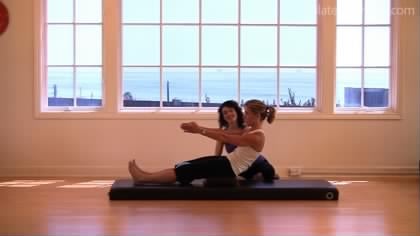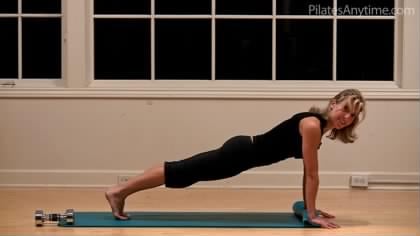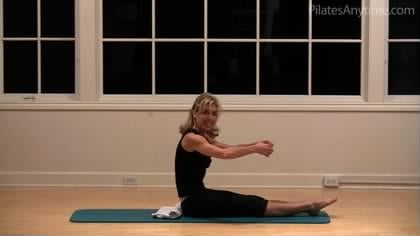Description
About This Video
Transcript
Read Full Transcript
Hi, I'm Karen Sanzo and I'm really happy to be back here at [inaudible] anytime. I'm going to start with a tutorial today on your head position. And I actually like to call this tutorial. Where's your head? Because a lot of times during the exercises we kind of forget the position that our head is in. So the first thing I'd like to talk about is where is your head in the supine position and when to profit?
So I'm just going to go ahead and lie down here on the mat in a very, very typical position with your knees bent, your feet flat, just looking right at the ceiling. So you'll notice in this position, I have a little space underneath my neck. I have my natural curve, I can check my neutral spine and all those things that we know how to do in platas fundamentals. But I'm gonna make something go a little wrong. So as I lift one leg up, everything stays the same. And as I lift my second leg up, you're going to pay special attention to what happens to my neck and my chest and my shoulders. I'm going to kind of make this happen. So I lift my second leg and you kind of see that I kind of lurch in my chest here and I'm trying to hold my pelvis and I'm trying to do all that stuff around here, but I've lost the integrity and the position of my neck. When this happens with a client, we need to support their position of dysfunction.
So what I'm going to do quickly is I'm going to get a little prop and I'm going to start with the most basic prop, which we usually say is it total. So I'm going to put the towel right there and I'm going to see, and I'm going to make a self assessment if this actually worked. So at home, if you try this, you really want to pay attention to your neck and your chest. So I'm going to take one of my hands. I'm going to use my right one and put it behind my neck. You can't really see it, but for the sake of the camera, I'm not gonna use my right arm. And as I lift my right leg up, I notice that my chest and my neck remain calm and there's an ease of movement and an ease of the breath. As I lift my second leg up, I feel the back of my net contract.
Oh my belly pubs out and I'm now, my voice is changing. Oh, I'm going to stop that. And I notice that my head is not prompt enough. So regardless of all the integrity that I keep down here, my pelvic floor, the ta and all that business that we know so well, if I lose integrity and the position of my neck, then the core of my neck, if you will, is not supported. So I'm going to come up, I'm going to get one more prop and I promise we're not going to be here a long, long time. But what I do want you to notice here is that some times we need a little higher prop than we think. So don't hesitate to create a successful position for your client that will come in here. Well, that will come in handy, but that will come in handy also in a lot of different places. Exercises.
So now I'm supported here and you'll notice that this little u shaped pillow has kind of given me a little neck extension, if you will. A little support here. My shoulders are heavy and some people can't have their hands down by their side because their shoulders move. So I'm going to go ahead and allow my hands to rest of my abdomen. I'm going to lift one leg up. I organize my core here, I relax my neck, I put my hand behind my head again, put my hand on my chest, and then when I lift the second leg up, I notice that I'm all organized here. My breath is easy.
So now the exercise becomes the breathing, inhaling and exhaling. And the breathing is actually the exercise because now I don't want to move or change integrity of my spine, of my neck or the spine and my back. And then I'm going to lower one leg down and the other leg down. I'm going to do one more variation because for some of you this is going to be really tough. So one last variation. I'm going to maximally prop,
You have to be creative here. So I'm going to take a moment here and set myself up and pull my, tell me, and I'm going to get myself all nice and situated here so that the, I'm going to put my legs down just so you can see. I've not really collapsed in here, so I've kept this distance relatively the same and now I'm going to put my hand on my chest or my neck to make sure that I'm not recruiting. Okay? All these external muscles. And then I'm going to lift one leg up and lift the other leg up.
And now I am supported sufficiently so that now I really, really feel the action of my core without being overly compensated in my neck. So it's going to be really important when you first start out that you support the neck appropriately. And this will paint a picture as we move further and further into a fundamental class and beginning level exercises.
The Successful Beginner - Playlist 2: Modifications for Classes
Comments
You need to be a subscriber to post a comment.
Please Log In or Create an Account to start your free trial.





















